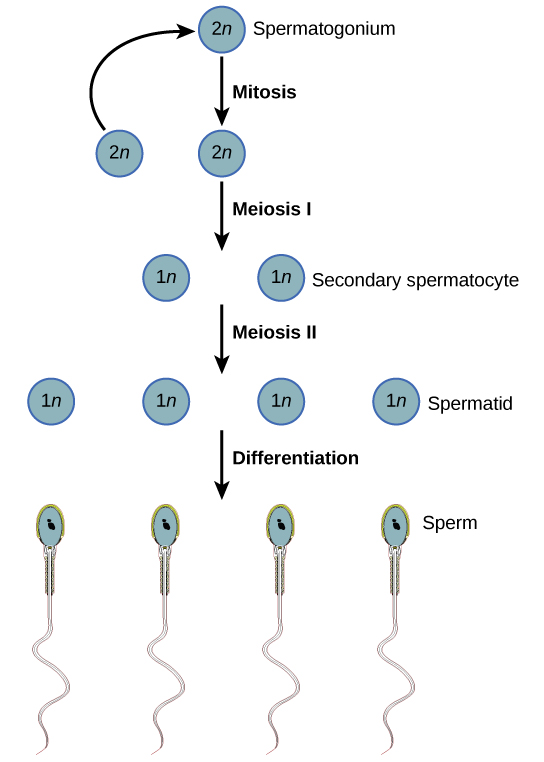In Spermatogenesis Meiosis Results in the Formation of
These cells are called spermatogonial stem cells. Spermatogenesis involves the differentiation of spermatogonial stem cells into spermatocytes via mitotic cell division and the production of haploid spermatids from the tetraploid primary spermatocytes via meiotic cell division.

Kinesins Are Involved In Each Step Of Spermatogenesis Kinesins Download Scientific Diagram
To maintain the chromosome number of an organism the gametes must be produced by what type of cell division.

. Spermatogenesis is the process of formation of mature sperm cells through a series of mitotic and meiotic divisions along with metamorphic changes in the immature sperm cell. Meiosis and Genetic Variability 2 In which step of urine formation is the glomerulus involved. What is the process of cell division that results in the formation of cells with the usual number of.
Divides by meiosis to produce two spermatids. Tosis results in the formation of preleptotene spermatocytes green cell. Spermatogenesis occurs in the testes.
Oogenesis is the formation of the ovum and spermatogenesis is the formation of the sperm. Spermatogenesis is a process in which the main male sperm cells undergo meiosis in order to produce cells that are referred to as spermatogonia. Four sperm cells with 23 chromosomes each.
Unlike mitosis meiosis in male mammals result in four haploid gamete cells by a process called. Remember that in mammals the heterogametic male XY determines the sex of the embryo. During spermatogenesis spermatids differentiate into spermatozoa.
Divides by meiosis to produce four spermatids. The second meiotic division meiosis II of spermatogenesis results in the formation of secondary spermatocytes. Cell that results from the division of spermatogonium and undergoes meiosis I and meiosis II to form spermatids spermatogenesis formation of new.
Mammalian spermatogenesis requires a stem cell pool a period of amplification of cell numbers the completion of reduction division to haploid cells meiosis and the morphological transformation of the haploid cells into spermatozoa spermiogenesis. In this process the mitotic division of a diploid spermatogonium results to two diploid intermediate cells that are referred to as the spermatocytes. During spermatogenesis pluripotent germ cells differentiate to become efficient delivery vehicles to the oocyte of paternal DNA.
Meiosis is a special process of reductional cell division. The preleptotene spermatocytes proceed through the rest of meiosis purple cell form haploid round or elongating spermatids orange cell and eventually elongated spermatids blue cell. It is the male version of gametogenesis which results in the formation of mature male gametes.
During spermatogenesis the first cells to become haploid are the _____. This results in cell division and multiplication to create a fetus. Gametogenesis involves spermatogenesis and oogenesis and results in the formation of haploid n sperm and eggs.
Two haploid sperm cells four haploid sperm cells four diploid sperm cells two diploid sperm cells CONCEPT four haploid sperm cells. It results in the formation of four gametes containing half 1N the number of chromosomes found in somatic cells. Divides by mitosis to produce a spermatogonium and a primary spermatocytes.
Meiosis II of spermatogenesis results in the formation of secondary spermatocytes. Meiosis is necessary for gametogenesis. During the phase of meiosis I a primary spermatocyte is converted into secondary spermatocytes.
During spermatogenesis spermatids differentiate into spermatozoa via. In spermatogenesis meiosis results the formation of. Unlike mitosis meiosis results in the formation of _____ cells.
This is the difference between meiosis and gametogenesis. Difference between spermatogenesis and oogenesis. Haploid gametes unite at fertilization to create a diploid zygote.
Spermatogenesis is the process by which haploid spermatozoa develop from germ cells in the seminiferous tubules of the testis. 1 Spermatogenesis results in the formation of _____. This review will discuss our.
The second mitotic division is quick and so very few secondary spermatocytes can be recognized in histological sections. This process starts with the mitotic division of the stem cells located close to the basement membrane of the tubules. The process of gamete formation is called gametogenesis.
This color key is maintained for the next few figures. Oogenesis occurs inside the ovary. Type A cells replenish the.
In this process all stages are completed in testes. Meiosis II of spermatogenesis results in the formation of secondary spermatocytes. Divide by meiosis to produce two secondary spermatocytes.
For a healthy offspring the number of chromosomes must be. These two processes are similar as they are. Secondary spermatocytes true or false.
Spermatids and spermatocytes are likely to be larger than their ancestral. Process of formation of male gametes. In mammals this takes place in the seminiferous tubules of the male reproductive.
In oogenesis eggs or ovum are produced from oogonia. Mammalian spermatogenesis requires a stem cell pool a period of amplification of cell numbers the completion of reduction division to haploid cells meiosis and the morphological transformation of the haploid cells into spermatozoa spermiogenesis. Divides by meiosis to produce two secondary spermatocytes.
In spermatogenesis sperms are produced from spermatogonia. Meiosis II of spermatogenesis results in the formation of secondary spermatocytes. The process of Spermatogenesis occurs to create mature male gametes which then fertilize female gametes to create a zygote a single-celled organism.
Meiosis produces haploid cells from diploid cells. The mitotic division of these produces two types of cells. The net result of these processes is the production of massive numbers of spermatozoa over the.
During the meiosis II phase the cells in turn are transformed into 1N. Though male and female germ cells both undergo meiosis to produce haploid complements of DNA at the same time they also each undergo distinct differentiation processes that result in either sperm or oocytes. False T or F.
Process of formation of female gametes. Meiosis II of spermatogenesis results in the formation of. Name the first haploid cell with 23 chromosomes produced during spermatogenesis.
The net result of these processes is the production of massive numbers of spermatozoa over the reproductive lifetime.

Gametogenesis Ck 12 Foundation


No comments for "In Spermatogenesis Meiosis Results in the Formation of"
Post a Comment